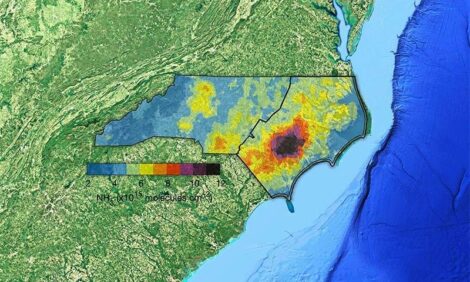



Romania Livestock and Products Annual - September 2005
By USDA, Foreign Agricultural Service - This article provides the pork industry data from the USDA FAS Livestock and Products Annual 2005 report for Romania. A link to the full report is also provided. The full report includes all the tabular data which we have omitted from this article.Report Highlights:
With animal herds still struggling to recover after the very severe drought
in the summer of 2003, the livestock sector in Romania is expected to grow in 2005 and
further. In 2004, swine meat became Romania’s top agricultural import (over $220 million
worth), a trend that is likely to continue in the short run, as domestic supplies are short and
of a variable quality. Live cattle continue to represent are a major agricultural export item of
the country. US exporters have competitively started using opportunities in pork cuts for
processing, although this situation may be in jeopardy, given the newly ratified Additional
Trade Protocol with EU.
In the beginning of the 2005, Romania’s swine stocks reached a low at 4.89 million heads
(almost 5 percent down from the previous year), a downward scenario mainly attributed to
the severe decrease in sow numbers and in particular in the reproduction stock in 2003. The
pig crop in 2005 is expected to start rising again, as the pig cycle reached its bottom in
2004, taking the end-year herds to an estimated 4.93 million.
The recovery will likely
accelerate in 2006, facilitated by a wide range of governmental programs meant to support
livestock population and production. The majority of this swine population (a steady 75
percent) is held in individual households. Nonetheless, some new commercial operations,
developed by private investors, domestic or foreign, are emerging. As an example, the
largest Romanian (and one of the largest by worldwide standards) integrated operation,
located the western part of the country, has been recently acquired by a major multinational
and recently revealed its intention to invest up to $800 million over the next five years to secure a strategic position on the domestic and the European markets. The company is
foreseen to become a major consumer of fodder and feed grains, as well as of services
delivered by local farmers and suppliers.
Data released by the Ministry of Agriculture show that, in 2005, only about 21 percent of domestic pork supply was delivered to processors, while the share of self-consumption increased to 63 percent (from 60 percent in 2004), with the balance directly sold on the retail market. An additional problem related to the domestically supplied hog meat is the wide variability in quality, often unacceptable for the processing industry. Consequently, the growing meat demand by local processing has more and more to rely on imports, which in 2004 were 37 percent up, from 123,000 MT carcassweight in 2003.
It is generally assessed that after Romania will become an EU member only the few farms currently equipped with competitive technologies will remain operational. Currently, the accession preparations related to food safety along the production chain (primary production, the production of animal feed and consumer safety) are being given a special emphasis, as the EU food industry is subject to strict sanitary regulations. Romania was granted a transition period until December 31, 2009 for modernizing and re-vamping its slaughtering and meat processing units, in compliance with the Community requirements, while products from establishments subject to transitional arrangements will not be sold to other Member States and will be clearly identified.
Currently, approved to export to EU, there are 8 plants for fresh meat (of which 2 are also approved for game meat), 5 for meat preparations and another 2 for meat products. In absolute numbers, this is how the Romanian industry is foreseen to look in 2010: out of the existing meat processing capacity (totaling 728,000 MT/year for slaughtering and, respectively, 777,000 MT/year strictly for processing), about 30 percent will be shut down. The veterinary authorities are strictly monitoring the efforts for revamping of the about 500 plants listed in the D category, “likely to be shut down” if they fail to begin restructuring and modernization by mid-2006. Currently, the official view is that such units have very slight chances to survive, given that by now only 5-6 percent of them were able to fulfil the requirements for acceding to a superior category.
CONSUMPTION
Per capita meat consumption in Romania is about 45 KG, representing half of the EU
average. Romanians show a strong preference for pork (about 50 percent of the total),
though chicken meat’s share in the average diet is increasing.
Animal protein intake is slightly increasing, but continues to be relatively low in the
consumption pattern (about 20 percent).
Production of processed meat products was in estimated at roughly EUR 330 million in 2004
(10 percent up from the previous year), with a similar trend into 2005. Domestic
consumption is still modest (8-9 KG/year/capita) and reveals some seasonality, with peak
periods in May-June and September-October.
According to a recent market survey published by “Ziarul Financiar”1, consumers base they
decision to buy on the following criteria: “tasty” fresh products (53 percent), affordable
price, reduced additive and preservative content (24 percent), reduced fat content (20
percent), reliable producer/brand (18 percent), no use of mechanically de-boned meat (17
percent), attractive aspect/color (15 percent). Also, domestic products are preferred to the
imported ones.
Overall, there is a trend towards buying more expensive, higher quality, branded products,
though more than half of the meat-processed products are still sold in bulk. A good
distribution through supermarkets and smaller points of sale plus an acceptable price/quality
ratio are factors that influence consumption of a certain brand. Packaging has also been a
very dynamic aspect in the Romanian food industry, reason for which companies
continuously diversify the presentation of their products on the shelves. Large domestic
companies are struggling to strengthen their brand names in an attempt to differentiate
themselves. There are thus several such brand names which already became “national” and
product diversification and expansion in niche markets are a natural trend.
Although the meat and meat product market continue to expand, the pace of growth has
decelerated lately. The top five meat-processing companies account for roughly 40 percent of
the market, but the enthusiasm of the foreign players (potential new entrants) is
diminishing, because of the rapid appreciation of pork prices in Europe and US, the limited
domestic supplies, as well as the unfair competition of the producers operating on the local
black market.
TRADE
One of the top Romanian agricultural exports has continued, in 2004 and 2005, to be live animals, especially sheep and cattle. Over 172,000 heads of bovine animals (20,000 heads more than in 2003), mainly fattening calves to be finished in the country of destination, were shipped in 2004 to Croatia, Greece Syria, Italy and Middle East countries. In the first semester of 2005, live cattle exports totaled 67,000 heads, shipped primarily to the same destinations plus other EU member states.
Further Information
To read the full report please click here (PDF format)
Source: USDA, Foreign Agricultural Service - Annual Livestock and Products Report - August 2005







